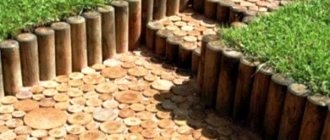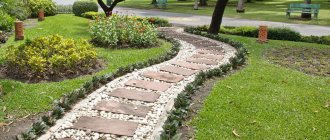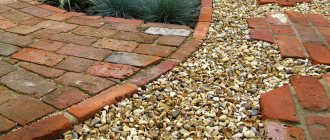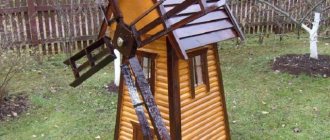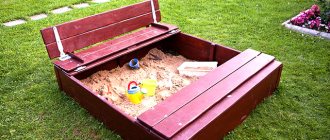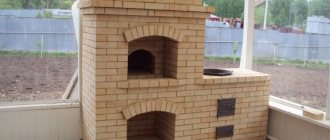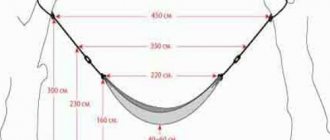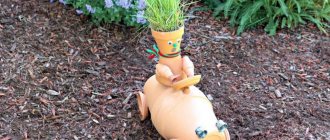From the history of the Russian state, we can learn that one of the most popular building materials was wood. At all times, good wood was valued; it was used not only as household utensils, but also for the construction of houses, various defensive towers and, oddly enough, roads. According to history, even Peter I began to use wood, almost as the main type of building material. Therefore, in today’s article I would like to pay great attention to wood, as one of the building materials for a summer house or country house, which would help eliminate the shortcomings of the site and bring charm to the design. Thematically, the article will be divided into several main sections for ease of understanding.
Advantages and disadvantages
Of course, in certain construction works, wood is virtually irreplaceable, in some cases it has unique properties, in others the ratio of advantages and disadvantages wins. However, regarding the construction of wooden paths, you need to understand certain advantages and disadvantages of wood. First, let's clarify the advantages:
- Environmental friendliness, it’s stupid to argue, but wood is one of the cleanest materials (excluding, of course, wood from contaminated areas, the same Chernobyl as an example).
- The thermal insulation properties of wood allow you to even run barefoot along such a path without fear of getting sick. But try to do the same with a stone or concrete path, the result will be the opposite.
- The material itself is cheap, especially since such a covering can be made literally from scraps of board left over from the construction of the same house.
However, there is another side to the “coin”, namely disadvantages:
- The main disadvantage is the lack of durability of such a coating. Of course, you can argue about this for a long time, but you need to understand that the service life can only be extended with the help of special protective materials and the like. When with brick, granite or the same stone, such problems do not arise at all.
- Problem with maintaining aesthetic appearance. It is sometimes difficult to keep track of a tree on a house, let alone on some garden path.
Read on the topic: GOST highways
Therefore, determine for yourself what is more important and closer to you, and from there think about what material will look most preferable on your site.
Features of operation
When using a path made of logs, it should be taken into account that wood is not a very durable material and is also susceptible to rotting and fire. Therefore, it is not advisable to set up a fire, compost pits or chop wood on it next to the path.
A log path in a dacha will last for many years, provided it is properly cared for. To do this, once a year it is necessary to clean and treat the garden path. It is done in the following sequence:
- Using a metal grinder brush or scraper, remove the top darkened layer of wood.
- Lightly sand the surface of the logs with coarse sandpaper.
- Treat the log cuts with an antiseptic 2 times, allowing the time specified in the instructions for the solution to absorb and dry.
- Coat the wood with drying oil or paint.
Damaged logs that cannot be renewed due to deep cracks or rot must be replaced with new ones and treated in the same way.
The best time for restoration work is the middle and end of spring, when there are no sudden changes in temperature or precipitation over the next few days.
Types and types of wooden paths
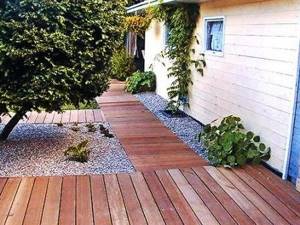
There are a huge number of variations in laying wood as a road surface, but not all of them are suitable for households due to certain nuances. Here is an example of the most common types of tracks:
- From tree cuts. By the way, it is gaining popularity primarily due to its low cost and excellent harmony with the environment, especially if there are trees planted on the site.
- From classic timber, laid like paving stones (cut into small squares) or in the traditional style of masonry walls.
- Made from boards laid on some kind of pedestal.
- Made from solid logs.
Next, we will analyze the features of laying some types of paths.
Do-it-yourself paths in the country at low cost
When conducting even a superficial analysis of the cost of certain types of materials from which garden paths are usually made, one can come to the conclusion that paths made of marble chips, crushed stone and gravel are considered the cheapest and most practical. They are not difficult to create, and their performance will not disappoint anyone.
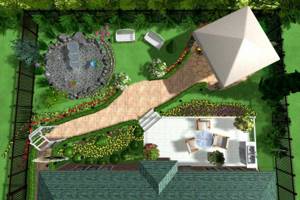
Landscape design project.
Brick, both solid and broken, can be successfully used for the budget construction of paths on the site. It’s good if you don’t need to buy it specifically for this purpose. Perhaps it was left behind when dismantling an old furnace or some building. Wooden stumps are an original and low-cost way to lay garden paths. The same can be said about plastic bottles, which you can collect as much as you like.

Garden paths made of plastic tiles.
The next material that does not require large installation costs is concrete. It is quite strong, practical and durable. If you use dyes, you can make paths worthy of attention from it. Moreover, for some time now various forms for making garden paths have appeared on sale.
Paths made from sawn wood

Before preparing saw cuts or stumps, the depth of their digging must be calculated, from which the height of the cut is calculated. They usually protrude 2-3 cm above the ground. Paths made from saw cuts are always dug in, which is why they are considered the most “solid” and stable.
As you can see for yourself, you can “lay out” the cuts as your heart desires: tightly, “less frequently,” with twists and in combination with other materials. Naturally, gaps always remain, so they are usually covered with stones or given to the local flora to be “eaten”
Paths made of wooden planks
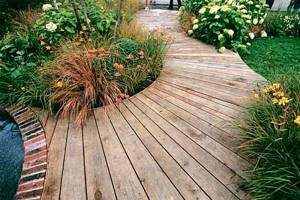
Garden paths are made from ordinary boards. For these purposes, boards can be specially purchased to order or waste from construction can be used. Naturally, each board will have to be processed with a plane to give it the desired shape. This stage plays a special role when it comes to wood waste, because they are usually “different sizes” and require adjustment. Tracks can be made “whole” without gaps or with “gaps.”
The “gaps” between the boards are usually filled with crushed stone or lawn grass is planted on them. Laying wooden paths with your own hands can be done in three ways: Simply lay them on top of the ground, without securing them with anything. They dig a little into the ground. Placed on top of a specially prepared frame made of wood or metal.
Read on topic: Laying paving slabs with your own hands (Step-by-step instructions)
Care
It’s not enough to simply lay wood blanks to make beautiful paths. It is also necessary to ensure proper care for them. In the first year, it is recommended to fill the voids between the wooden pieces. For filling, you can use fine crushed stone or sand.
A good option is to let nature fill in the cavities. In a year, the grass will turn green between the harvests.
Advice! To prevent the growth of weeds, fill the cavities with fertile soil and sow lawn grass. Decorative plants will fill the voids in a short time, and such a path will look even more unusual.
The wood can be left untouched, aged artificially, or the stumps can be painted in variegated colors. You will get an original path: children will certainly appreciate such a fun design.
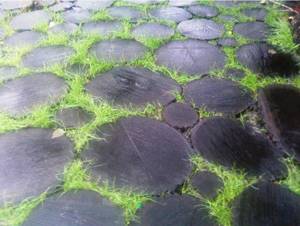
Features of care:
- Set aside one day every year to prevent the condition of garden paths - use an iron scraper to clean round timber;
- after cleaning, cover the workpieces with drying oil or paint;
- inspect the wooden blanks: if there are cracks on them, this indicates a rotting process, the damaged parts will have to be replaced.
Recommendation: at the initial stage, when preparing consumables for creating a garden path, put several blanks in the shed in order to replace damaged ones over time.
Paths made of wooden beams
As for timber, it is considered a more expensive material, so it is used much less often. Paths made of timber are much stronger and more durable. They look more neat and “noble”.
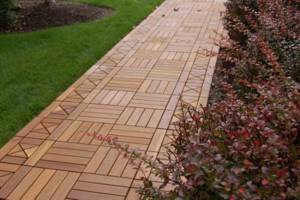
To save money, you can use the same “intermediate” method as with boards, or combine timber with other types of materials. You can even consider various combinations with logs or saw cuts, try to make passages or bridges from timber, it will look great.
Tip: the “digging” method is especially relevant for cases where groundwater lies close to the surface. Naturally, the boards will have to be treated with special attention to prevent the negative effects of moisture.
How to make a wooden garden path with your own hands?
Like any work, laying a garden path in a country house from the same wood requires a certain stage, even technology. The following stages can be distinguished:
Preparation for installation
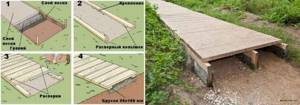
First, you need to mark the future path using stakes, rope and a regular tape measure, so that in the future you do not fall behind the schedule. In this way, you can immediately outline the area where the garden path at the dacha will pass, and at the same time determine what additional work will be required. For example, on the “route” of a path, there is a tree, a stone boulder, or anything else. You need to get rid of this or beat it somehow, think over some design solution.
Then you need to prepare the soil: remove the top layer of turf and dig a trench if you are going to dig the wood deep into the ground. Often 10-20 cm is enough. Now you can start lining the bottom of the trench with waterproofing film or roofing felt and laying drainage. Gravel, crushed stone or a mixture of them and sand can be used as a drainage cushion.
Material
First, prepare a “pillow”; you have already determined what material you will need; now it is advisable to decide what kind of wood you will use, what texture, and so on. Do not forget that the wood will have to be further processed, for example, trimmed, stained or treated, especially if there is a high level of groundwater.
Read on topic: Concrete slabs for roads
Technology
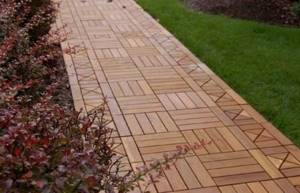
In this section, everything is limited solely by your imagination and the type of material chosen; on the Internet there are indeed many different solutions for laying the same saw cuts, beams, logs or ordinary boards, some of which are given in our article.
At the final stage, the wood is laid in accordance with your design idea and compacted. The gaps and gaps are then filled with gravel, crushed stone or sand. Your garden path is ready. More “complex” projects with lighting from below and a frame under a wooden flooring are carried out according to the same algorithm, but before laying the wooden flooring, the wiring and lighting system are “hidden” in the frame.
Tip: it’s best to tamp with a mallet. A hammer is suitable for these purposes, as it can cause damage and cracks to the wood itself, which will spoil the aesthetic appearance.
Technological sequence
Softwood lumber is a low-budget option. Of course, if possible, it is better to choose beech or oak. When properly treated, such surfaces do not absorb moisture and last for decades. Antiseptic solutions protect wood from the harmful effects of insects. If you need to increase the resistance of the material to mechanical stress, it is better to use varnish or paint.
When using solid boards, preference is given to products of the same length. For complex paths with changes, combinations of planks of different sizes are suitable. When working with wood you will need a plane, nails, a hacksaw, self-tapping screws and a grinder.
A belt sander is more suitable for rough surfaces. It can be used to cut parts as accurately as possible along the marking line. Due to the tape rotating in a circle, the wooden surface can be given any shape.
Preparing the base
Depending on the type of soil and the expected load on the path, the depth of the trench ranges from 20-25 cm. Moreover, its width should coincide with the width of the path. Polyethylene film can be used as a waterproofing material. This material has high tensile strength and elasticity. It is better to lay polyethylene in a continuous layer. If one part of it is not enough, you will have to glue several film sheets with an overlap of 30 cm. To do this, you will need to use construction tape or electrical tape.
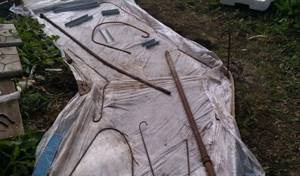
The depth of burying logs depends on the type of soil
To prevent the wood from swelling from moisture, it is better to pour fine gravel on top of the waterproofing layer. Backfilling of sand and crushed stone must be done according to the building level. Otherwise, instead of the planned straight path, it will turn out to be wavy.
Workpiece processing
It is best to soak the logs in an antiseptic solution. This is the most economical way to prepare compact workpieces. The surface of larch or oak can also be coated with a protective compound using a roller. It is advisable to apply 4-5 layers of the substance, and take the already treated material to a well-ventilated place. The minimum drying time is 48 hours. If there are more protective layers - 72 hours.
The cut logs need to be sorted by size, cleared of bark and discarded destroyed parts. High-quality material can be treated with drying oil. For this purpose, it is better to use a boiling substance that clogs the wood pores. This treatment will prevent pest attacks, and the ability to absorb moisture will not exceed 2%.
Wood can be treated with antifungal agents using a spray bottle. If you don’t like its natural color, try aging the material using artificial methods, for example, painting light-colored alder cuts with copper sulfate. After this they will take on a dark shade. The lower part of the products must be thoroughly impregnated with hot bitumen.
Laying the path
At this stage, the logs can be laid in accordance with any pattern or in any order. They are usually installed on a sand base. Then tamp down a little and level. The gaps between the lumber are hidden with crushed stone. Sawdust and moss are suitable for processing seams on top.
There is nothing complicated in laying a path, the main thing is to follow simple rules
In order for the garden path to last at least 5 years, during the installation process it is important to adhere to the following rules:
- along the entire length of the path, large cuts are laid first, and only then small ones;
- small trimmings from pear branches will help hide the voids;
- stone fences will make the contours clearer and with their help, construction waste will remain in the depths of the seams, and will not be spread throughout the entire site;
- the optimal distance between cuts is 1-1.5 cm, since in this case the path will take on a more natural look, which is especially important for areas arranged in eco-style.
Paving paths from boards involves preliminary waterproofing of the trench, strengthening the frame and installing the flooring. At the same time, building materials can be laid not only on a perfectly flat base, but also on a hill.
Exquisite decor
You can plant jasmine, lilac or weigela along the paths. A unique feature of the latter shrub is the riot of colors and aromas during the flowering period. The opened corollas change colors... every few hours! The species with ash, red and beige bells are more popular among gardeners. You can also use conifers and bulbous plants as decoration. For a herbaceous border, blue fescue and Italian setaria, more popularly known as “chumiza,” are suitable.
Along the path you can plant flowers, shrubs, and put up garden figurines
See also: what to plant along the path for successful decoration.
Considering that wood goes well with sea pebbles, glass, boulders and plastic, you can bring to life the most unexpected decor options.
How to care?
There is no unanimous verdict on this topic, both from specialists and households. For some, naturalness is more pleasing to the eye, when over time the tree fades, the bark begins to peel off, cracks appear, and the like. Someone, on the contrary, excludes the appearance of any kind of shortcomings and tries to get rid of them. It all depends on the person.

Of course, it is stupid to leave such garden paths in the countryside unattended; periodically you need to tint the same boards or beams, peel off the bark, and so on. We will also give one piece of advice: if for some reason weeds have climbed through the “cushion”, it is better to eliminate them immediately, otherwise after a couple of years the wood may rot completely, especially if groundwater lies close to it.
